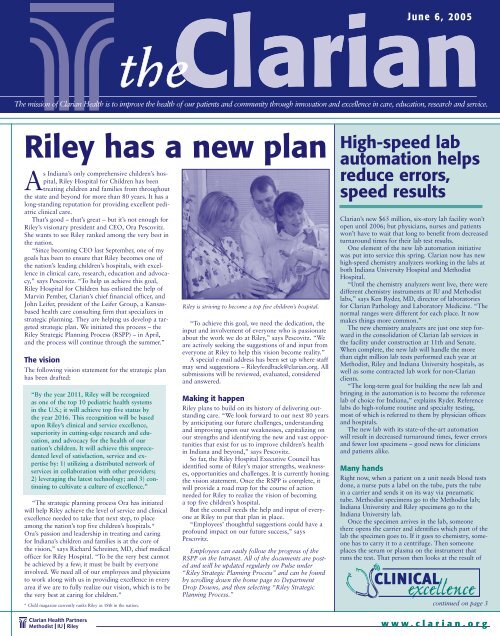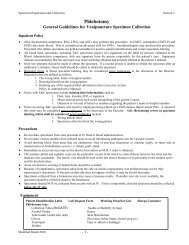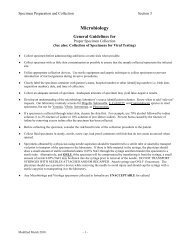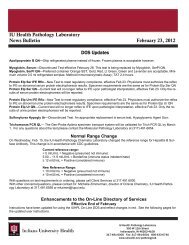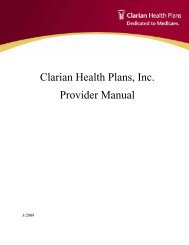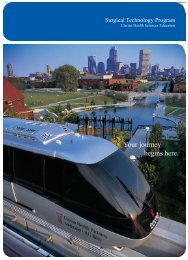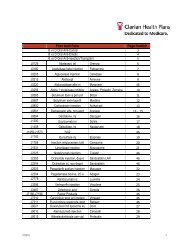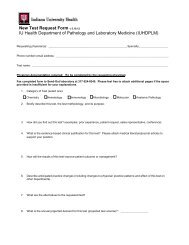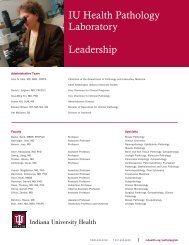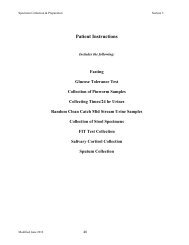Download PDF - IU Health
Download PDF - IU Health
Download PDF - IU Health
Create successful ePaper yourself
Turn your PDF publications into a flip-book with our unique Google optimized e-Paper software.
theClarianJune 6, 2005The mission of Clarian <strong>Health</strong> is to improve the health of our patients and community through innovation and excellence in care, education, research and service.Riley has a new planAs Indiana’s only comprehensive children’s hospital,Riley Hospital for Children has beentreating children and families from throughoutthe state and beyond for more than 80 years. It has along-standing reputation for providing excellent pediatricclinical care.That’s good – that’s great – but it’s not enough forRiley’s visionary president and CEO, Ora Pescovitz.She wants to see Riley ranked among the very best inthe nation.“Since becoming CEO last September, one of mygoals has been to ensure that Riley becomes one ofthe nation’s leading children’s hospitals, with excellencein clinical care, research, education and advocacy,”says Pescovitz. “To help us achieve this goal,Riley Hospital for Children has enlisted the help ofMarvin Pember, Clarian’s chief financial officer, andJohn Leifer, president of the Leifer Group, a Kansasbasedhealth care consulting firm that specializes instrategic planning. They are helping us develop a targetedstrategic plan. We initiated this process – theRiley Strategic Planning Process (RSPP) – in April,and the process will continue through the summer.”The visionThe following vision statement for the strategic planhas been drafted:“By the year 2011, Riley will be recognizedas one of the top 10 pediatric health systemsin the U.S.; it will achieve top five status bythe year 2016. This recognition will be basedupon Riley’s clinical and service excellence,superiority in cutting-edge research and education,and advocacy for the health of ournation’s children. It will achieve this unprecedentedlevel of satisfaction, service and expertiseby: 1) utilizing a distributed network ofservices in collaboration with other providers;2) leveraging the latest technology; and 3) continuingto cultivate a culture of excellence.”“The strategic planning process Ora has initiatedwill help Riley achieve the level of service and clinicalexcellence needed to take that next step, to placeamong the nation’s top five children’s hospitals.*Ora’s passion and leadership in treating and caringfor Indiana’s children and families is at the core ofthe vision,” says Richard Schreiner, MD, chief medicalofficer for Riley Hospital. “To be the very best cannotbe achieved by a few; it must be built by everyoneinvolved. We need all of our employees and physiciansto work along with us in providing excellence in everyarea if we are to fully realize our vision, which is to bethe very best at caring for children.”Riley is striving to become a top five children’s hospital.“To achieve this goal, we need the dedication, theinput and involvement of everyone who is passionateabout the work we do at Riley,” says Pescovitz. “Weare actively seeking the suggestions of and input fromeveryone at Riley to help this vision become reality.”A special e-mail address has been set up where staffmay send suggestions – Rileyfeedback@clarian.org. Allsubmissions will be reviewed, evaluated, consideredand answered.Making it happenRiley plans to build on its history of delivering outstandingcare. “We look forward to our next 80 yearsby anticipating our future challenges, understandingand improving upon our weaknesses, capitalizing onour strengths and identifying the new and vast opportunitiesthat exist for us to improve children’s healthin Indiana and beyond,” says Pescovitz.So far, the Riley Hospital Executive Council hasidentified some of Riley’s major strengths, weaknesses,opportunities and challenges. It is currently honingthe vision statement. Once the RSPP is complete, itwill provide a road map for the course of actionneeded for Riley to realize the vision of becominga top five children’s hospital.But the council needs the help and input of everyoneat Riley to put that plan in place.“Employees’ thoughtful suggestions could have aprofound impact on our future success,” saysPescovitz.Employees can easily follow the progress of theRSPP on the Intranet. All of the documents are postedand will be updated regularly on Pulse under“Riley Strategic Planning Process” and can be foundby scrolling down the home page to DepartmentDrop Downs, and then selecting “Riley StrategicPlanning Process.”High-speed labautomation helpsreduce errors,speed resultsClarian’s new $65 million, six-story lab facility won’topen until 2006; but physicians, nurses and patientswon’t have to wait that long to benefit from decreasedturnaround times for their lab test results.One element of the new lab automation initiativewas put into service this spring. Clarian now has newhigh-speed chemistry analyzers working in the labs atboth Indiana University Hospital and MethodistHospital.“Until the chemistry analyzers went live, there weredifferent chemistry instruments at <strong>IU</strong> and Methodistlabs,” says Ken Ryder, MD, director of laboratoriesfor Clarian Pathology and Laboratory Medicine. “Thenormal ranges were different for each place. It nowmakes things more common.”The new chemistry analyzers are just one step forwardin the consolidation of Clarian lab services inthe facility under construction at 11th and Senate.When complete, the new lab will handle the morethan eight million lab tests performed each year atMethodist, Riley and Indiana University hospitals, aswell as some contracted lab work for non-Clarianclients.“The long-term goal for building the new lab andbringing in the automation is to become the referencelab of choice for Indiana,” explains Ryder. Referencelabs do high-volume routine and specialty testing,most of which is referred to them by physician officesand hospitals.The new lab with its state-of-the-art automationwill result in decreased turnaround times, fewer errorsand fewer lost specimens – good news for cliniciansand patients alike.Many handsRight now, when a patient on a unit needs blood testsdone, a nurse puts a label on the tube, puts the tubein a carrier and sends it on its way via pneumatictube. Methodist specimens go to the Methodist lab;Indiana University and Riley specimens go to theIndiana University lab.Once the specimen arrives in the lab, someonethere opens the carrier and identifies which part of thelab the specimen goes to. If it goes to chemistry, someonehas to carry it to a centrifuge. Then someoneplaces the serum or plasma on the instrument thatruns the test. That person then looks at the result of* Child magazine currently ranks Riley as 18th in the nation. continued on page 3www.clarian.org
Long-time lab employee a leaderin lab automation project3If you want to know about the new chemistry analyzersat Clarian, there is one person to talk to. If youwant to know about the new immunochemistry analyzersabout to roll out at Clarian, there is one personto go to. If you want to know about the new roboticsystem going in at Clarian hospitals and the new labbuilding, there is one person who knows all about it.That person is Pam Vollmer.Vollmer is the chemistry technical coordinator forLaboratory Services at Clarian, and her bosses say shehas been a vital part of the planning and execution ofthe lab automation project.Vollmer started as a medical technologist atIndiana University Hospital in 1976 and has held avariety jobs in the labs at <strong>IU</strong> and Riley in the interveningyears.“Everyone who has ever worked with Pam comesaway with great respect for her abilities in the lab,”says Ken Ryder, MD, director of laboratories forClarian Pathology and Laboratory Medicine. “Whenany of the medical technologists that work in thechemistry lab have a question, they automaticallytake it to Pam. She either knows what to do or willfigure it out; always, never fails.”Vollmer was on the committee that helped determinewhich lab automation system would be best forClarian. She listened to vendor presentations, helpeddevelop spreadsheets to compare the various systemsand even went on site visits to see the potential systemsin action.Pam Vollmer says the lab automation project is themost challenging assignment she’s worked on in hernearly 30-year career at Clarian.Challenging and exciting“This project has been the most challenging andexciting project I have ever worked on,” admitsVollmer. “Over the years, we have heard about therobotics coming into the laboratory. It’s just taken along time to get going. In the past, we have had bitsand pieces of automation roll out, but this is the firstcomplete system.”Vollmer’s role in the project keeps her at work – a lot.“She is here seven days a week except for a rareday off,” says Ryder. “During emergencies, such asCerner downtimes, she stays for the duration of theproblem – sometimes working 30-hour or longershifts. A junior member of our pathology faculty toldme he could not recall ever being in the hospital withoutseeing Pam. I don’t know how she does it.”It’s all about patientsVollmer says it helps to keep the patients in mind.“We don’t see the patient or the end result,”explains Vollmer. “But the thought of the patient isalways there. Especially when we get the samplesfrom Riley, we are aware that we have a limitedamount of a sample and that we have to do whateverwe can to conserve it. Even though we don’t see thepatients, we still know what we are doing is veryimportant for them.”After already spending about 18 months on theproject, Vollmer says the thought of a vacation alsohelps keep her going. She is hoping to take a shortbreak when Phase I of the lab automation projectis complete later this summer.High-speed lab automation helps reduce errors, speed results continued…the test and manually accepts or rejects the results bypushing a button on the computer. Then someonemust take the tube of blood and put it in a refrigerator,where it is saved for a couple of days, in case aphysician wants to “add on” another test of thespecimen or redo a test. Along the way it is touchedby a number of hands.Robotic automationWhen the new lab building is complete and functional,physicians and nurses won’t need to do anythingdifferently, except ensure that the label on the tube iscorrectly applied. The tube still goes in a carrier andinto the pneumatic tube system. But this is where thebig changes begin.The pneumatic tubes, three running each wayfrom each hospital, will carry each specimen to thenew lab building. There, a person will touch thespecimen for the last time. The lab worker will takethe specimen out of the carrier, double-check theplacement of the label, and send it on its way downthe new automated track.Ryder explains the new journey for specimens.“The robot takes it to the centrifuge, if necessary.If that is not needed, it just moves it to the analyzer.If it goes to more than one workstation, the robotopens the tube, takes enough of the specimen outand places the proper amount in daughter tubes,labels the daughter tubes, and takes everything to theinstruments. The instruments run the tests, and thenthe robot takes it and puts it in the refrigerator. Ifanother add-on test or re-test is needed, you just goto your computer and order it. The robot retrievesthe specimen and does the requested work.”Ryder says even though most people refer to itas a “robot,” the automation is really more like aCoca-Cola bottling line.Did you know?In 2004, Clarian labs performed 8.2 millionlab tests. That’s 16 results everyminute of every day, all year long.The labs’ workload has grown 10 percenteach year for the last five years. Andwith the addition of Clarian West, it maygrow at an even faster rate.He says decreasing the number of hands touchingeach specimen decreases the chance that an error willbe made or that the specimen will be lost, becausecomputers will track the specimen at each step ofautomation. But he says the big benefit will be ahuge decrease in turnaround time – the amount oftime it takes from when the specimen reaches the labuntil the results are available by computer.“Right now, it takes somewhere between 60 and90 minutes for the whole process to take place,”says Ryder. “When all the automation is in place,that time should be greatly reduced.”Ryder says lab experts from Clarian spent 18months visiting health care facilities across the countryto see how their automated systems functionedbefore selecting the system Clarian wanted. He saysthe system is so fast that there is no concern aboutfreezing weather disabling the pneumatic tubes. Andwhile he says there is always the remote possibilitythat a carrier could get stuck in a tube, it has neverhappened at the facilities they studied, some ofwhich (like the Mayo Clinic) have used the systemfor decades.Sam Odle, president and CEO of Methodist andIndiana University hospitals, is excited by the newlab facility and automated systems.“One of the most important foundations in ourability to deliver patient care second to none is timelyand accurate clinical lab results,” says Odle. “Ourlaboratory staff has designed a strategy to deliverclinical laboratory results in a manner that is unlikeany other hospital in Indiana. The state-of-the-artlaboratory robotic system will assure accuracy, timelinessand quality laboratory results for Clarianpatients and physicians.”To learn more about Clarian lab automation, contactPam Vollmer at 274-0144 or pvollmer@clarian.org.
4<strong>Health</strong>Net physician recruits teamfor medical mission in BoliviaDuring his last year of residency, Rick Reifenberg,MD, an internist/pediatrician with Clarian’s<strong>Health</strong>Net Community <strong>Health</strong> Centers, caughtthe medical mission bug. Since then, he’s inspired severalof his colleagues with the mission spirit.It was in 2000 that Reifenberg first became interestedin serving an international rotation. The young doctorfound a group from DePauw University planning atrip to Montero, Bolivia. He signed on and spent twoweeks there, treating patients ranging in age from newbornsto senior citizens.Reifenberg was so fulfilled by the experience that herecruited fellow <strong>Health</strong>Net physician Kathy Cohenourand Clarian physicians Deanne Kashiwagi and MichaelReeder to join him. The group now makes an annualtwo-week pilgrimage to Bolivia, which is the poorestcountry in South America, and second only to Haiti asthe poorest country in the entire Western Hemisphere.Highs and lowsThe Bolivians seen by the doctors live in a harsh environmentwith little infrastructure. Extreme geographicelevations and unbalanced diets contribute to a highdeath rate among Bolivian women and children frompreventable illnesses such as pneumonia, diarrhea, malnutritionand gastrointestinal complications.“I saw a three-year-old girl die from untreated pneumonia,”explains Reifenberg. “She had been in the hospital,but her parents were unable to afford the antibiotics– so she simply didn’t receive any. It’s a tragedy,and something we can hardly fathom in our ownhealth care system. In Bolivia, it is economic reality. Ibelieve this is also why we see so much genuine gratitudefrom the patients we serve there.”Potable water and sanitation systems are rare. ManyRick Reifenberg, MD, examines a child with tuberculosis ofthe spine.people are a full day’s walk from the nearest medicalfacility. As a result, the physicians see 400 to 500patients during each visit, many of whom are sufferingfrom malnutrition, respiratory or skin infections, orparasites.“It is exhausting, and at the same time exhilarating,”says Reifenberg.Year-long preparationThe mission program the four participate in operatesin more than 200 Bolivian communities near themunicipalities of Ancoraimes, El Alto and Montero.Volunteers provide maternal and reproductive healthcare, tuberculosis intervention, education about childsurvival techniques, micro-enterprise development andwater sanitation.Reifenberg, Cohenour, Kashiwagi and Reeder preparefor the trip and solicit support for their work inBolivia all year long. Reifenberg travels to his nativeFort Wayne to speak to students at Bishop DwengerHigh School, his alma mater. The students there hold afundraiser and contribute about $500 per year to themission project. Park Tudor in Indianapolis also supportsthe project, as does Methodist Hospital’s WhiteCross Guild.Reeder seeks donated medicines from pharmaceuticalcompanies, which the group then carries with themon their trip. “When I trained at Methodist, there wasan emphasis placed on providing indigent care,”explains Reeder. “They [the Bolivian people] have atremendous need for our expertise and our supplies,and they don’t have access to the supplies without usphysically bringing them with us.”All four doctors pay their own travel expenses anduse vacation time for the annual medical mission. Theybring with them medical supplies, cash donations andeven clothing for the local orphanage in Montero,which is run by a Polish nun.Internet may helpFive Bolivian-trained doctors staff the clinics. Whilethey lack some of the technical expertise of Americanphysicians, Montero’s health care system today is moresophisticated than one might expect. The Bolivian doctorsnow have an established clinic system, and keepcharts and statistics. They have Internet access, andReifenberg hopes to capitalize on that Web access.“Long term, we’d like to get enough money toimprove their Internet access, develop some better software,and be able to recruit doctors here to communicateand consult on cases for Montero patients. We’realready getting support from doctors here to consult,”explains Reifenberg.In the meantime, the annual mission trip, saysReeder, “revitalizes me. It makes me more patient andmakes me realize the enormous material wealth in ourown country. It’s a humbling experience.”If you are interested in participating in this project,contact Reifenberg at rreifenb@clarian.org.Deanne Kashiwagi, MD, with a patient at the orphanage in Montero, Bolivia.
5Q: Why is Clarian changing its smokingpolicy?A: Secondhand smoke is the third leading cause of preventabledeath in the United States. As a health careleader, Clarian has a commitment to the health andsafety of its patients, visitors and employees. Childrenat Riley have sometimes not been able to play outsidedue to nearby secondhand smoke (SHS); chemotherapypatients have become ill from the smell of SHS; visitorswith asthma have suffered respiratory distress fromSHS that has resulted in visits to the ER; and severalmulch fires have been caused by inappropriate disposalof cigarettes.Q: Whom does the policy affect?A: Everyone who is on Clarian’s owned or leasedproperties – patients, visitors, employees, volunteers,physicians, students, contract employees, contractorsand service representatives.Q: How is this different from Clarian’scurrent smoking policy?A: Clarian currently has a smoke-free environmentinside the buildings. The new policy affects groundsand all properties owned or leased by Clarian.Clarian’s intention is to create a healthier and saferenvironment for patients, visitors and employees byeliminating the harmful effects of secondhand smoke.To that end, smoking will be prohibited in all Clarianbuildings, on all properties and grounds and in companyvehicles. This prohibition includes walkways, parkinggarages and tunnels, or within a 30-foot perimeterof any entrance, whichever is greater.Q: Why was smoking selected versus otherhealth risks?A: Many people – smokers, patients, and probablyeven some health professionals – aren’t aware howmuch smoking impacts health care and recovery. Bymaking the campus environment smoke-free, Clarianis addressing the number one health risk today for itspatients, visitors and employees.Answers to yourquestions aboutClarian’s newsmoke-freecampus policyAs Clarian’s smoke-free campus target date of July 1 rapidly approaches,Clarian is striving to clarify the policy and keep employees informed of justwhat the new policy means for them. The most frequently asked questionsabout the new policy – and Clarian’s answers to them – are shown here.Plus, just as many patients, visitors and employeesare sensitive to perfume, for which Clarian has a longstandingpolicy, so too are many people adverselyaffected by SHS or the particulates it leaves behind.Because particles from smoke stick to clothing, hair,skin, etc., – more so than many smokers realize – andcan trigger attacks in those who have asthma or nauseain patients undergoing chemotherapy, Clarian does notwant its employees to smoke during work hours andrisk causing an adverse reaction in a patient, visitor orcolleague.Q: What is the impact at IndianaUniversity Hospital?A: The smoke-free campus policy addresses all ownedand leased facilities. Riley Hospital, <strong>IU</strong> Hospital,Methodist and Wishard will implement the smoke-freecampus policy on July 1. Employees are expected to berespectful of neighboring residents and businesses,including <strong>IU</strong>PUI and Wishard, by not loitering in frontof homes or businesses or by inappropriately discardingtobacco products.Q. Do I have to quit smoking?A: No, Clarian is not asking you to quit using tobacco.But you cannot smoke on the campus and you arestrongly encouraged to refrain from smoking duringwork hours, including during rest and lunch breaks,even when you are off campus. If you smoke off campusand then return to work with particles of tobaccosmoke in your hair, clothing and on your skin, sensitivepatients or colleagues who are exposed to those particulatesmay become ill as a result.However, if you are interested in quitting, a numberof resources are available to help you quit, includingthe Clarian Tobacco Control Center (962-9662);Methodist Medical Group (962-2549); GeorgetownMedical Plaza (962-2549); East Washington MedicalPlaza (962-2549); Glendale Medical Plaza (962-2549);<strong>Health</strong>y Results for You (962-1792); Try to Stop(trytostop.org); National Quitline ((800) QUITNOW)and Tobacco Free Nurses (tobaccofreenurses.org/).continued on page 6Survivaltips forsmokersNo one denies that getting through an eight- or12-hour shift without nicotine is going to bedifficult for anyone addicted to the powerfuldrug.“Tell your coworkers and colleagues howthey can help support you,” advises PattyHollingsworth, manager of the <strong>Health</strong>y Resultsfor You program. Most people understand thatsmokers are struggling in an increasinglysmoke-free world.Over-the-counter nicotine replacementproducts like nicotine-replacement gum andlozenges will be available for purchase atClarian gift shops and pharmacies by July 1,and will be available for purchase in the hospitalcafeterias when the gift shops are closed.Sam Flanders, MD, senior vice president ofmedical quality for Clarian, notes that employeeswho smoke will be able to “feel good aboutthe fact that they don’t have the smell of smokeon their clothes, so they are not running therisk of passing a chemotherapy patient whomight become nauseated by the smell of smokeon them, or of triggering an attack in a personwith asthma.”And it might help to think about the moneyyou are saving by smoking fewer cigarettes. Tryto keep track of the cigarettes you no longersmoke under the new policy. Figure out howmuch money you are saving and do somethingspecial for yourself with the money that wouldotherwise have gone for tobacco products.And when all else fails, try to maintain asense of humor. Laughter can go a long waytoward relieving stress.Keep a sense of humor. Laughter can helprelieve stress.
6Answers to your questions about Clarian’s new smoke-free campus policy continued…Or, your personal primary care physician can assistyou in quitting.Q: What pharmacological therapies areavailable to Clarian employees?A: There are a number of pharmacological therapiesthat can aid in “kicking the habit,” many of which arecovered by health insurance plans. Discuss with yourphysician what will work best for you.There will be limited availability of subsidized overthe-counternicotine replacement therapy for employeeswho attend a designated cessation program. You mustregister for a program by Monday, June 20. Details ofthe cessation programs and registration are availableon Pulse, or call the Clarian Tobacco Control Centerat 962-9662.Q: What resources are available to helpemployees struggling with this change?A: Clarian has a number of employee support systemsincluding EAP (962-3838 or 274-0911); Chaplaincy(962-8611 or 274-7415); Buchanan CounselingServices (962-8613); Massage Therapy (962-3950);<strong>Health</strong>Works (962-8104 or 274-6712); and Behavioral<strong>Health</strong> Services (962-2622).Massage therapy canhelp decrease stress.workplace smoking to protect nonsmokers from thehealth problems that may be caused by secondhandsmoke. On May 23, Indianapolis passed such a lawthat will affect the majority of workplaces and takeeffect March 1, 2006.Q: Will parking garages be smoke-freeas well?A: Yes, parking garages are critical, as patients, visitorsand employees walk through them to get insidethe doors of Clarian hospitals. Smoking is prohibitedin garages and in personal cars on Clarian property.Q: Is clinical training for patient tobaccoassessment and intervention available?A: Yes, four clinical training modules called “TobaccoCounseling and Intervention” are on e-LMS. Clinicalstaff should complete the four modules before July 1.Q: Is employee training on the smokefreecampus policy and implementationavailable?A: Yes, all employees are encouraged to reviewModule 1 of “Tobacco Counseling and Intervention”training e-LMS. This module will be available June 15.Q: Do nicotine replacement PhysicianOrder Protocol and Oversight Groupsexist for patients?A: <strong>IU</strong>OPOGs and MOPOGs are available on Pulseunder “General Order Sets.”Q: Given the stress that families faceduring hospitalization, how does thepolicy support these individuals?A: Providing a safe and healthy environment forpatients is Clarian’s primary responsibility. “Survivalkits” with educational materials will be provided tothose smokers who need assistance. Nicotine replacementproducts will be available in the hospital giftshops. Night-shift employees can refer visitors to thecafeteria cashier to buy nicotine replacement gum andlozenges. The cafeterias will only sell nicotine replacementproducts when the gift shops are closed.Q: Won’t this policy just send smokers torestrooms, stairwells and other areas?A: While the potential exists, the hope is that all willembrace the effort to sustain a healthier environmentfor patients, visitors and staff. It is Clarian’s responsibilityto help staff, patients and visitors in this process.All staff will be empowered to enforce this policy.Still have questions? Send them to The Clarian attheclarian@clarian.org. If enough new questions arereceived, additional questions and answers will be publishedin the June 20 issue of The Clarian.Q: Does the policy affect employees at facilitiesoutside of the downtown hospitals?A: Yes, Clarian West already has a smoke-free campus,and Clarian North will open as a smoke-free campusas well. The policy applies to employees at all sitesowned or leased by Clarian, including Gateway.Q: Isn’t this a violation of my civil rights?A: The policy underwent legal review and was foundto be reasonable. The basis for Clarian’s position isthat smoke via whatever transfer device (personalsmoking or secondhand smoke embedded in the skin,clothing, hair, etc.) can and does have an impact onthose who are exposed to it – whether they arepatients, visitors or fellow employees.Smokers’ rights laws do not prevent employers fromregulating or restricting smoking on their premises orworksites. In fact, many states impose restrictions onQ: How will the new policy be monitored?A: Employees seen smoking on the grounds will bereported to their units. Supervisors will take action asthey would any other violation of policy up to andincluding discharge.Employees are to refrain from smoking duringworking hours off campus as well, to avoid bringingthe contaminants of tobacco smoke that remain onone’s body and clothing into the care and work environment.Those contaminants can trigger adverse reactionsin patients and colleagues similar to those causedby excessive perfume or other fragrances. If such contaminantscreate an issue when an employee arrives atwork or returns from breaks, management will intervenewith education and coaching. Repeated issues canresult in formal corrective action.Q: Can visitors smoke at Clarian?A: For the health of Clarian’s patients, visitors andemployees, visitors may not smoke on Clarian property.Q: How do I tell patients and visitorsabout our smoking policy?A: You can simply state, “For the health and safety ofour patients and visitors, smoking is not allowed onour campus.” Palm-size cards with this information areavailable from Customer Services or may be downloadedfrom Pulse.Do not be confrontational. If a visitor becomesbelligerent, contact Clarian Safety and Security.
iefly speakingbrieflyNEWS YOU CAN USEFairbanks Ethics Fellowship applicationsApplications are available online for the ethicsfellowship program sponsored by the CharlesWarren Fairbanks Center for Medical Ethics.Eligible applicants include Clarian nurses,chaplains and social workers, although othersmay apply by special arrangement. The applicationdeadline is June 30, 2005.The fellowship program begins inSeptember. It requires a 12-month commitmentof approximately eight hours per week.Fellowship activities will be concentrated onone day each week. Fairbanks fellows will continuefull-time employment at their regularjobs, but will be permitted time away fromnormal work assignments to participate in fellowshipactivities.Details about the fellowship and the applicationare available on the Fairbanks CenterWeb page, accessible through the Pulse homepage under the departmental drop-down menu.Choose “Medical Ethics Center” and then clickon “Fellowship Application Now Available.”For more information, contact Patty Bledsoeat 962-9258 or pbledsoe@clarian.org.Clarian North hiring eventsInternal information sessions for currentClarian employees interested in positions atClarian North Medical Center will be held onthe downtown campus at the following timesand locations:Thursday, July 14Methodist Hospital, Room DG422A7:30-9:30 a.m.3:30-7:30 p.m.Friday, July 15Riley Hospital, ROC Conference Room A7:30-9:30 a.m.Tuesday, July 19Indiana University Hospital, Cancer Pavilion,Room RT1023:30-7:30 p.m.An external hiring event also is scheduledfor Monday, June 18, from 4:30-8 p.m. at RitzCharles in Carmel. This event is open to thoseinterested in any of the job opportunities atNorth.Have a budding science investigator athome?Is your child interested in mixing up somechemical reactions, building a geodesic dome,solving a crime from the Mad Science files orlearning about the ins and outs of the humanbody? Then sign up him or her for the alldayhealth/science camp presented by MadScience and the Ruth Lilly <strong>Health</strong> EducationCenter during the week of June 20. Formore information, call 388-0988 or visitmadscience.org/INDY.EMPLOYEE AND FAMILYWELLNESSChildren’s <strong>Health</strong> and Safety Fair at theIndianapolis ZooThe Indianapolis Zoo will hold the Children’s<strong>Health</strong> and Safety Fair inside the new DolphinPavilion Tuesday, July 12, from 10 a.m. to3 p.m. Riley Hospital for Children is a corporatesponsor of the zoo. Many Clarian partnersare participating in the fair, offering children’sactivities as well as health information andscreenings for parents.Willing 2 Wait summer campDo you have a teen beginning to experience thepressures teenagers encounter? Help your childsurvive these trying times by enrolling them inthe 2005 Willing 2 Wait-Baby Think It Overprogram for adolescents age 12-16. This twodayclass addresses adolescent sexuality,teenage pregnancy, how to resist negative peerpressure and media messages, and helps kidsunderstand the effects of sexually transmitteddiseases, alcohol, tobacco and other drugs onthe body.While discussing all of these pressures, participantswill have the opportunity to view teenparenting in a realistic way with the latest editionof the realistic Baby Think It Over infantsimulator. When a teen takes responsibility forthe infant simulator for two days, he or shelearns just how much feeding, burping, rockingand diaper changing an infant requires.Summer classes are scheduled on theMethodist campus for June 16-17, June 23-24,July 13-14, July 20-21 and August 3-4. Classesrun from 9 a.m. to 4 p.m.Cost is $15 per student. Scholarships areavailable for low-income families. Each class islimited to 10 students.For more information or to enroll, contactJamie Rogers at 962-3692 or jrogers3@clarian.org.OF INTERESTClarian <strong>Health</strong> Vascular Labs accreditedby ICAVLThe <strong>IU</strong> Vascular Diagnostic Center of Clarianwas awarded accreditation April 12 by theIntersocietal Commission for the Accreditationof Vascular Laboratories (ICAVL) in the areasof noninvasive extracranial cerebrovascular,peripheral arterial, peripheral venous and visceralvascular testing. The center has a locationat Methodist and one at Indiana UniversityHospital.Michael C. Dalsing, MD, is medical directorfor the labs, which are staffed by DebraHinchman, Angela Beck, Christa Dixon, SarahMcCool, Cara Mendenhall, Chris Jones andDanielle Boggs, all of whom are registered vasculartechnologists.The Indiana University lab first receivedaccreditation in extracranial cerebrovascular,peripheral arterial and peripheral venous testingin 1993 and has maintained those ICAVLaccreditations.This most recent accreditation was attainedwith the initial application submitted for visceralvascular testing of the renal and mesenteric arterialsystem. The Clarian noninvasive vascularlabs are currently the only labs in Indianapolisor the adjacent counties to hold ICAVL accreditationin the area of visceral vascular testing.The accreditation period is valid for three years.Participation in the accreditation processdemonstrates the laboratories’ attention to ahigh level of patient care and quality testing.Every aspect of the labs’ daily operations isreviewed. ICAVL is a non-profit organizationwith the support of 11 medical societies includingphysicians, technologists and sonographersthat represent medical specialties including cardiology,neurology, radiology, vascular medicine,vascular surgery, neurosurgery, internalmedicine and biology.For more information, contact DebraHinchman at dhinchma@clarian.org or962-0222.ACS recognizes Clarian with two awardsThe American Cancer Society recently recognizedClarian’s cancer education and informationefforts with two awards. Clarian was presentedwith the Five-Star Investor Awardbecause of the multiple fronts on which it fightscancer in the workplace. Clarian and itsemployees are active in the Making StridesAgainst Breast Cancer and Relay for Lifefundraising events, as a smoke-free worksite,and through numerous special events andsponsorships.Clarian was recognized as a hospital activein the fight against cancer through theAmerican Cancer Society’s programs with theFive-Star Community Investor Award. ACSprograms with which Clarian has beeninvolved include the Breast and CervicalCancer Control Program, Cancer Survivors, theLook Good, Feel Better program, and numerousscreenings and tobacco-related activities.You can learn more by calling Jane Berby-Todd at 962-6597.VOLUNTEERSSocial drinkers needed for alcohol researchThe <strong>IU</strong> Alcohol Research Center seeks socialalcohol drinkers, age 21-30, who have a fatheror another sibling who is – or ever has been –an alcoholic. Social drinkers without a historyof alcoholism also are needed. After an interview,each qualified person will need to completeeight visits, two of which include a twonightstay in the hospital, to measure howresponse to alcohol relates to family history ofalcohol problems and to recent drinking patterns.The study takes place at IndianaUniversity Hospital. For information, call278-6551 or e-mail erptest@iupui.edu.Established drinkers needed for alcoholresearchThe <strong>IU</strong> Alcohol Research Center seeks establishedalcohol drinkers, age 21-30, who have afather or sibling and one other relative (otherthan your mother) who is – or ever has been –an alcoholic. Established drinkers without ahistory of alcoholism also are needed. After aninterview, each qualified person will need tocomplete four visits, two of which will requireabout five hours to measure how response toalcohol relates to family history of alcoholproblems and to recent drinking patterns. Thestudy takes place at Indiana UniversityHospital. For more information, call 278-6551or e-mail erptest@iupui.edu.Help defeat diabetesMore than 500,000 Indiana residents areaffected by diabetes, a serious illness with veryserious complications. Team up with coworkers,family members and friends to help finda cure by joining the American DiabetesAssociation for the America’s Walk forDiabetes on Sunday, September 25, at VictoryField. Choose between a three-mile or four-mileroute. For more information, call (888) DIA-BETES or visit diabetes.org/walk.7Construction updateNow closed:• access to University Place Hotel from the IndianaUniversity Hospital second-floor bridge andaccess to the bridge from the AOC entrance,until approximately Friday, July 15Lane closuresEffective Monday, June 27:• the far west lane of southbound UniversityBoulevard south of <strong>IU</strong> Hospital’s outpatiententrance• the far north lane of Michigan Street fromUniversity Boulevard to Barnhill DriveOther closingsEffective Monday, June 27:• <strong>IU</strong> Hospital staff entrance on Michigan• glass walkway between <strong>IU</strong> Hospital and theCancer Pavilion• skywalk between Vermont Street garage and<strong>IU</strong> Hospital• metered parking lot/patient drop-off lot offMichigan StreetFor more information about these closuresand about parking during the construction, see theMay 23 issue of The Clarian, available on Pulseunder “Online Publications.”
classifiedadvertisementsHow to place a classified ad:Clarian <strong>Health</strong> employees, volunteers,physicians and retirees may placeclassified ads. There is no charge forthis service; however, ads are subjectto editing for length or clarity. Ads arepublished on a space-available basis.• Ads must be placed by noon, twoThursdays prior to the publication date.• Ads must be submitted in writingto The Clarian in any one of thefollowing ways: Fax to 962-4533,e-mail TheClarian@clarian.org or mailto The Clarian, Classified Advertising,950 North Meridian Street, Suite 1200,Indianapolis, Indiana, 46204.• Ads cannot be placed by telephone.• Ads run for one issue only.• All ads must be legible and includeemployee name, department andwork telephone number so eligibilitymay be verified.• Each ad must be less than 25 words,not including item price, employeename and home number. Only homenumbers will be published. The Clarianis not responsible for any mis-use ofpublished phone numbers.• No personal services or privatebusiness advertising is published.OOPS!Medical dictation bloopersBoth right eyes are red with discharge.Next, I ran through the duodenum.Please go back to that last transcription and please donot transcribe it.Want to post your ad electronically? Log onto pulse.clarian.org and post your ad – andeven a photo of the item – in the Classifiedsection of the Clarian Intranet. After youritem has sold, you can erase the listing –no more phone calls after the item is gone!wheels, PS, TW, PW, PL, PD,AM/FM/CD/CASS, alarm system,$19,900. Call Rick at 845-0861.• 2002 Procraft boat, completely Bassrigged, 50 hp Mercury motor,power tilt and trim, 2 depth finders,$7,000. Call Curt at 244-9097.• 1991 Honda Accord LX, 5-spd.,new clutch, master cylinder, transmissionand timing chain, goodtires, $2,500. Call 709-0179.• 1998 Intrepid, loaded, all power,68K miles, clean, runs good,$4,500. Call Eddie at 997-4165.Critters• Beagle puppies, 2 females, 8 mo.old, would like to keep together,from champion blood lines, needfenced yard or farm-type setting torun, free to GOOD home. Both parentsalso available. Call Alma at422-0824.• Orange tabby cat, declawed infront, neutered, gets along wellw/kids and dogs, free to GOODhome. Call Leigh at 341-5092.Thank youA special thanks to 6North/6South forbeing so kind and caring for my dad,Elder Irvan Ward, Sr., who passed awayMarch 20, 2005. The staff was alwaysprofessional, pleasant, and very polite.Your kindness will always be appreciated.Also a special thanks to Dr. Weir,Methodist ER, for sending my dad toYellow Rose, where he could maintainhis pride and dignity until the end.The family of Elder Irvan Ward, Sr.,father of Luella M.Watson, MA,PhD/MBHC/<strong>Health</strong>Net8For Sale• Multi-family garage sale: Sat., June18, 8 a.m.- 3 p.m., 915 E. 54th St.(corner of 54th and Guilford), furniture,draperies, collectibles, jewelry,much misc. No phone calls.• Sears Kenmore stackablewasher/dryer w/rack, $175 OBO.Call 546-2655.• Formula One tickets, PaddockPenthouse, box 9, row K, seats 3and 4, start/finish line, under cover,$300. Call Yvonne at 577-2386.• Tiffany-style 30 emerald cut diamondring, white gold, 3.30 dwt.total wt., 1.76 ct. total diamond wt.,$3,300. Call Rachel at 781-6801.• Garage sale: June 18, 7 a.m.-2 p.m.,5639 Dapple Ct., vintage hallmarkornaments and collectibles, fishtank, household items. No phonecalls.Housing, Property• For sale: 3 BR, 2.5 BA, loft, 2-cargarage, all appliances, washer/dryer,custom blinds, easy access to I-65,I-465, 12 min. to MH/<strong>IU</strong>/RI,fenced yard, $145,000. Call Billat 299-5393.• For rent: 1 BR, half-double, basement,detached garage, extras, minutesaway from both campuses,Irvington, $425/mo. Call Barbaraat 849-5802.• For rent: 3 BR, 2 BA, 2-car attachedgarage, pool, tennis, trails,Zionsville, 16 min. to Methodist,$950/mo. Call Brian at 873-4324.• For sale: 3 BR, 2 BA, 2-car attachedgarage, fenced back yard, .25 acre,Hancock County, near 62nd andPendleton Pike, near I-70, 25 min.to Methodist. Call 965-4327.• For rent: Orlando, 6 mi. fromDisney, 3 BR, 2 BA, private, heatedpool, year round, rates start at$115 per night depending onseason, references, photos atTshell14@aol.com. Call Jamieat 784-4398.• For sale: 3 BR, 2 BA, DR, FR, lg.kit., all hardwoods, finished basement,2.5-car garage, fenced yard,Broad Ripple, $199,000. CallChristie at 255-7720.Autos, Boats, Etc.• 2000 Ford Taurus 48K miles, AC,AT, CC, PW, PD, PL, PS, PB, tiltwheel, keyless entry, alarm, $5,995.Call 818-1889.• 2002 Olds Bravada, 48K miles,4.2 liter V6, leather, heated memoryseats, power everything, alloywheels, OnStar, $15,500. Call413-1045.• 1989 Four Winns Horizon 180 skiboat, 18 ft., 4.3 liter V6, road andmooring cover, Bimini top, $5,200.Call 326-3653.• 1993 Kawasaki Jet Ski (Waverunner), 750 cc, SS w/trailer,$1,500. Call 326-3653.• 2003 Hyundai Tuscani Tiburon,premium and winter wheel/tire pkg.,premium speakers w/CD, 28Kmiles, pictures available, $16,500OBO. Call Keith at 884-1709.• 1996 Pontiac Grand AM, 96Kmiles, AT, V6, 4-dr., new batteryand tires, $2,950 OBO. Call481-8550.• 2005 Dodge Caravan, 3.3 V6,privacy glass, dual side doors, alloyClarian discounts help yousave moneyClarian employees are eligible to join Curves in downtown Indianapolisat a deeply discounted cost. New members pay a $39 service fee –normally $149 – and a monthly fee of $29. You must sign up for a minimumof one year to qualify for the discount. Current Curves membersare eligible for one free month, a savings of $29. For more information,call 685-8206.For more information about other discounts available to Clarian employees,see the 2005 Clarian Employee Handbook.American, Danish and Canadian scientists are studying theeffects of music on 400 randomly selected patients whilethey undergo various medical procedures. Patients listento music through a pillow during their procedure, thenare asked to rate their anxiety levels after the procedureis completed.Preliminary findings indicate music can be powerful medicinewhen it comes to reducing stress, anxiety, worry andfear. One of the lead researchers – who initially was skepticalthat music would have a significant effect – says he nowurges physicians to address their patients’ emotional healthas well as physical conditions, rather than focusing solely onthe physical.Early findings also indicate that listening to music duringthe medical procedures plays an “important adjunct role” inregulating heart rate, respiration and blood pressure, accordingto the Seattle Times.Bioengineered tendons may offer new hope in the not-so-distantfuture for people with damaged or destroyed shoulderrotator cuffs.Damaged rotator cuff tendons – that’s the tendon thatconnects the shoulder’s ball and socket joint – are difficult torepair surgically and cannot be regenerated by the body.However, scientists at University of North Carolina Schoolof Medicine believe they are close to developing new technologythat will provide an effective treatment that is muchless invasive than today’s rotator cuff surgical procedures.UNC School of Medicine researcher Albert Banes, PhD,told Ivanhoe Broadcast News, “We will take human cells,put [them] in a three-dimensional gel and fabricate thisbioartificial tendon.” The researchers hope the same technologywill eventually lead to bioengineered ligaments and skin.This column is based on news collected by The Clarian staff fromsources within Clarian and throughout the world of health care.If you have a suggestion for this column, or if you see somethingin this column that suggests a Clarian story idea to you, pleasecontact the editor at:The ClarianAttn: Kathleen Martin950 N. Meridian St., Suite 1200Indianapolis, IN 46204Call 962-4527 or e-mail kmartin3@clarian.org.Sources other than those noted above used to compile this columninclude the <strong>Health</strong> Care Advisory Board Daily Briefing and<strong>Health</strong>Scout.com.“Work while you have the light. You are responsible for the talent that has been entrusted to you.” – Henri-Frédéric Amiel


